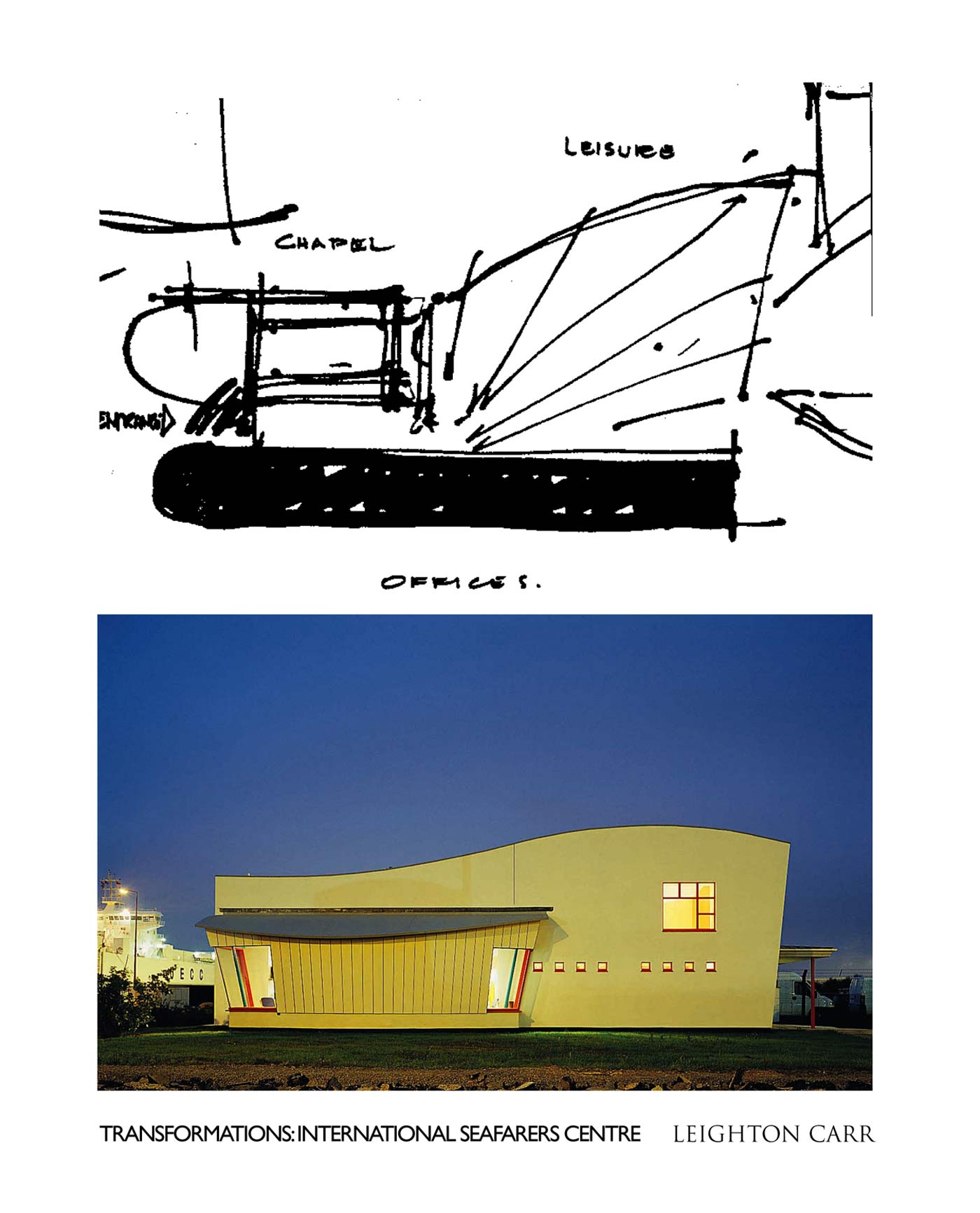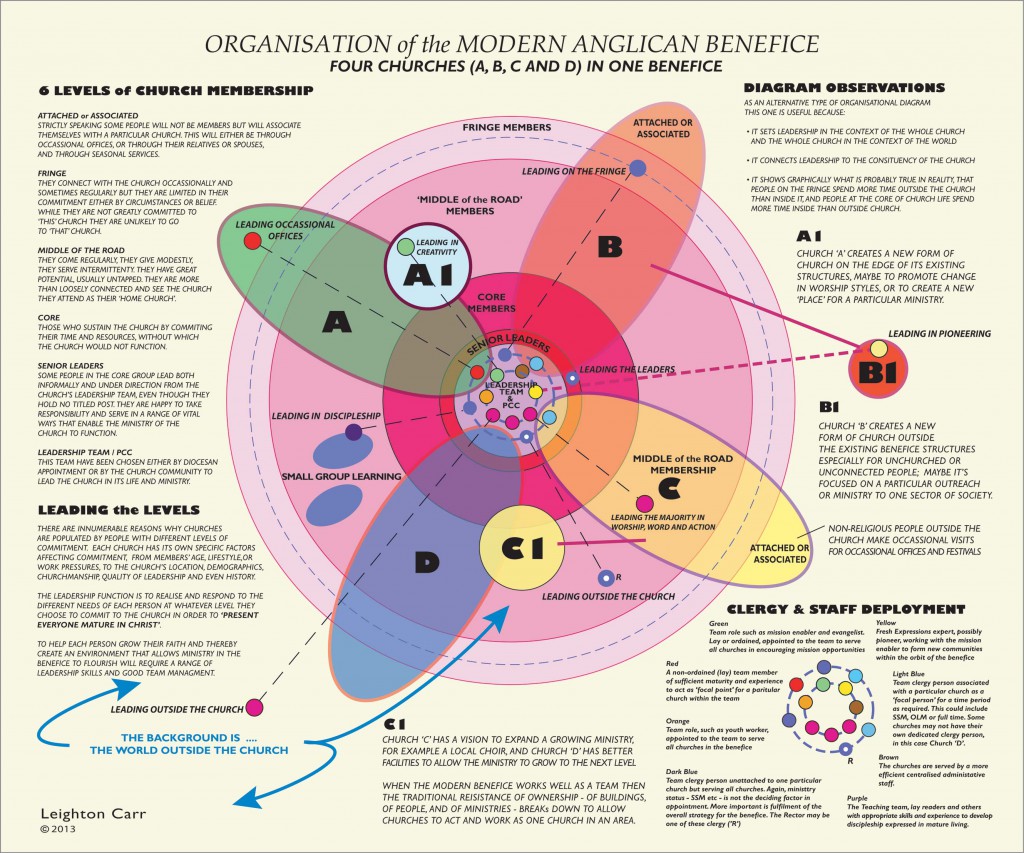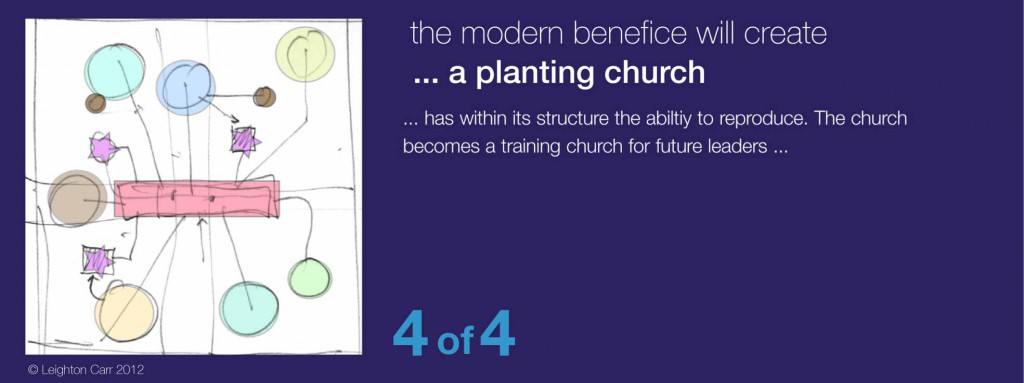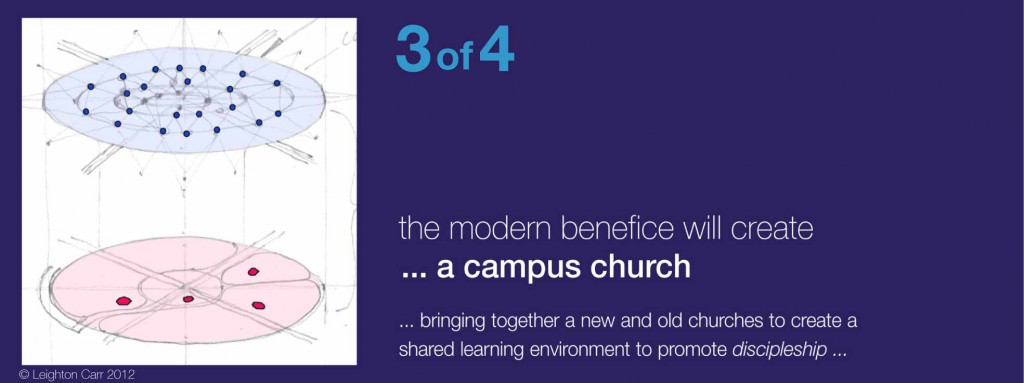Reorganisation of the Modern Anglican Benefice
It would be reasonable to assume that most Church of England clergy are uncomfortable with the idea of simply transferring business models and methods into the church.\r\n\r\nAs the church wrestles with questions of long-term sustainability some new thinking about structures has to be carried out, and it is not enough to simply adopt a streamlined management plan from a profit-motivated organisation and hope that the Anglican church can adapt. For start, most corporate internal organisation charts don’t include the client; they focus instead only on the Team, which can be controlled, not the public, (and for public read ‘Ordinary Church Member’).\r\n\r\nIt was reflecting on this problem which led to the doodle which led to the diagram below. It proposes an alternative organisational diagram for the modern Church of England Benefice.\r\n\r\nFor a larger version for zooming in see here.\r\n\r\nOn the same subject see Models of the Successful Modern Church of England Benefice\r\n
Hijacked Epiphany
While shopping early today (yes, shopping on a Sunday) there were Easter eggs on sale alongside the Christmas leftovers in the Asda clearout.\r\n\r\nIt’s January 6th\r\n\r\n- the twelfth day of Christmas\r\n- the day Anglicans celebrate Epiphany\r\n- and there are Easter eggs on sale.\r\n\r\nIn fact, before Christmas there were Easter eggs on sale next to Christmas gifts at the local Shell petrol station. Stocking fillers?\r\n\r\nIn some ways it’s to be expected. It’s what happens when a secular society gets hold of a Christian festival without the patience and understanding to see it through.\r\n\r\nBut it’s not only a feature of a secular society. For many churches the rush in and out of festivals happens at an equally startling pace.\r\n
- \r\n
- It’s as though churches have caught the impatience around them rather than expressing their own mature patience to see the season out.
- It’s as though we need to be always turning to something new or, God forbid, the congregation might get bored.
\r\n
\r\n
\r\nIt is written into the seasons of the church, especially in Church of England liturgy, that time should move slowly, which admittedly is hard in a fast world.\r\n\r\nSo how about using these words when planning our way out of our festivals:\r\n
Dwell. Wait. Watch. Feel. Hear.
\r\n(PS: Maybe it can go too far? I also heard today of a man who celebrates Christmas until 2nd February (Candlemas) by leaving Christmas decorations up outside his house. 40 days?)
Leaf (2)
The successful modern Church of England benefice 4 – Planting
The successful modern Church of England benefice is an organic, networked and campus church, created for growth and witness. It is the logical outworking of this new Anglican focus that the successful benefice will find opportunities to share its resources and experience and expertise with other churches and in other places. It will become a Planting church. At times this will mean offering help to Anglican and other churches experiencing difficulties, and at other times it will mean starting new ventures of different shapes and styles to meet particular needs and opportunities.\r\n\r\nThis is 4 of 4: to see the whole poster go here\r\n\r\nOr see each individual post here: 1-Organic 2-Networked 3-Campus\r\n\r\n
The successful modern Church of England benefice 3 – Campus
The successful modern benefice in the Church of England will need to become a Campus. This means it will draw together resources for teaching, mentoring, coaching and training, for the purpose of helping Christians deepen their discipleship and witness. Lay ministers will need to work in a more flexible way, working in teams, with each person working to their strength, be it research, writing, preaching, coaching. The Campus church will also attract external resources from outside the Anglican church – theologians and educators – as well as offer resources to all local colleges and schools (not only Church of England schools!) to build up the life of society as a whole.\r\n\r\nThis is 3 of 4: see the whole poster go here\r\n\r\nOr see each individual post here: 1-Organic 2-Networked 4-Planting\r\n
Promotion, Preferment, Sacrifice
Its job hunting time for curates all over the country, and on Friday mornings new jobs are advertised in the Church Times (today’s are in Ireland, Scotland and Brittany – tempting – and a school in Ashford). Depending on the rules of their particular diocese curates in their third or fourth year have to move on and many are keen to go, ready to spread their wings and take more responsibility.\r\n\r\nAnd yet.\r\n\r\nTraining for ministry is not just about ‘learning the ropes’, as it’s inelegantly called. Occasional offices. Running a PCC meeting. Preaching. Not ruining worship services.\r\n\r\nSkills aren’t enough.\r\n\r\nAnd that is because – if leading in ministry is not empowered by a tangible, dynamic, and forceful spiritual authority then it will waste the good time of congregations and fail a world that is, according to Jesus, waiting for someone to step up (Matthew 9/Luke 10).\r\n\r\nThe alternative to a ministry of Spirit Empowered Spiritual Authority is a well practised ministry that is ineffective in the spiritual world, and consequently unfruitful in the temporal one too.\r\n\r\nSo how is spiritual authority gained?\r\n\r\nUnfortunately this aspect of the job cannot be taught by Diocesan training staff or learned easily in theological colleges.\r\nIt doesn’t come with the job, and it isn’t conferred by a hopeful PCC.\r\nIt doesn’t come automatically with the Bishop’s license to minister, and it isn’t handed out with a promotion.\r\n\r\nNo, spiritual authority in leadership comes from the public and private practice of surrender and sacrifice. And as Jesus modelled in the Gospels, it is often discovered in the desert.\r\n\r\nWhich means that in trying to make sense of some of our hardest years of leadership behind or ahead we should take encouragement from the following quote about the road to spiritual authority in leadership:\r\n\r\nIt is not won by promotion, but by many prayers and tears. It is attained by confession of sin, and much heartsearching and humbling before God; by self surrender, a courageous sacrifice of every idol, a bold uncomplaining embrace of the cross, and by an eternal, unfaltering looking unto Jesus crucified. It is not gained by seeking great things for ourselves, but like Paul, by counting those things that are gain to us as loss for Christ. This is a great price, but it must be paid by the leader who would not be merely a nominal but a real spiritual leader of men, a leader whose power is recognised and felt in heaven, on earth, and in hell.\r\n\r\nSamuel Logan Brengle
The successful modern Church of England benefice 2 – Networked
A successful modern Church of England benefice will need to be Networked. That is, it will need to work across churches of different styles, theology and history, and across parish boundaries. Networked churches will make the most of resources, limiting duplication to maximise effectiveness and sustainability. To create and environment for sustainable growth the successful benefice will draw on the expertise of many people wherever they are found, in Anglican churches and others.\r\n\r\nThis is two of four: see the whole poster go here\r\n\r\nOr see each individual post here: 1-Organic 3-Campus 4-Planting\r\n\r\n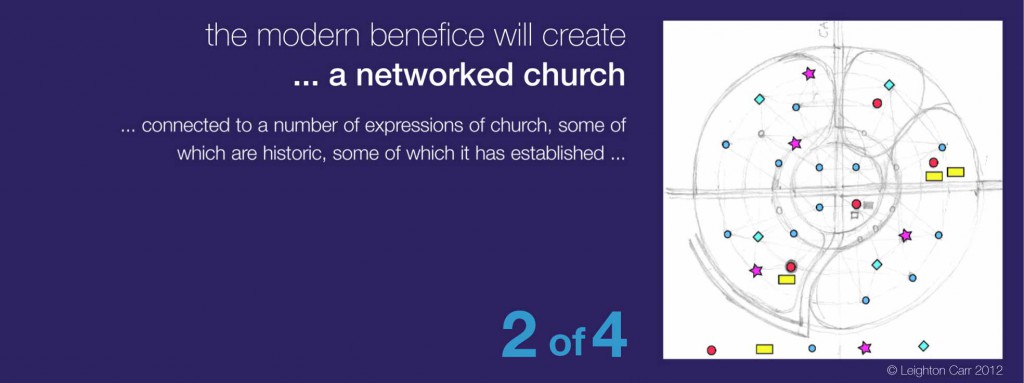 \r\n\r\n
\r\n\r\n
- The Networked Benefice
Counting blessings on the walk to work
After working way into the early hours of this morning on seemingly impossible problems, tired, under pressure, my day was suddenly elevated by the walk to work.\r\n\r\nThe sun in the city. There’s nothing like it to pick up a sluggish pace and open jaded eyes.\r\n\r\nIt’s a blessing, I think, as I pause for thought over coffee in Bordeaux Quay before heading to the studio taking photos along the way … on the iPad mini!!\r\n\r\n\r\n\r\n \r\n\r\n
